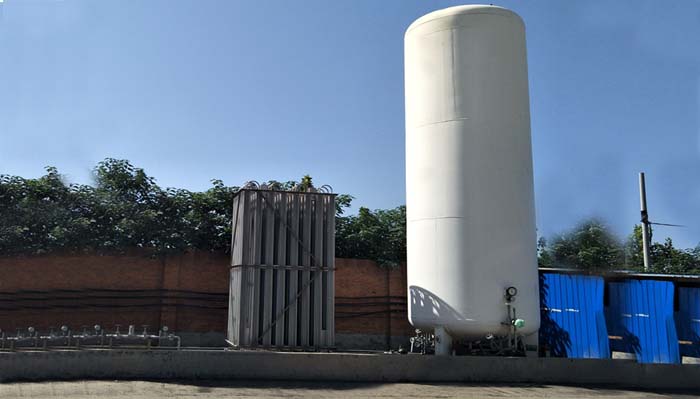Product Category
Manufacturing process and process parameters of pressure vessels
Date: Mar 12, 2020

When it comes to pressure vessels, you can think of it as a very large tank. This is just an understanding of its initial image. In technical terms, a pressure vessel is a closed device that holds gas or liquid, such as an LPG storage tank and cryogenic oxygen nitrogen and argon storage tanks are a type of pressure vessel. But do you know its manufacturing process? The following introduces the manufacturing process and process parameters of pressure vessels.
1. Different welding methods have different welding processes. The welding process is mainly determined according to the material, grade, chemical composition, welding structure type, and welding performance requirements of the workpiece to be welded. First of all, we must determine the welding methods, such as hand arc welding, submerged arc welding, tungsten argon arc welding, melting electrode gas shielded welding, etc. There are many types of welding methods, which can only be selected according to specific conditions. After the welding method is determined, the welding process parameters are formulated, and the types of welding process parameters are different.
2. The pressure vessel manufacturing process can be generally divided into: raw material acceptance process, scribing process, cutting process, rust removal process, machining process, rolling process, pairing process, welding process, non-destructive testing process, and opening scribing process , General inspection process, heat treatment process, pressure test process, anti-corrosion process. The process parameters of pressure vessels are the main basis for the design and safe operation of pressure vessels. The main process parameters of pressure vessels are pressure and temperature.
The process parameters of pressure vessels are the main basis for the design and safe operation of pressure vessels. The main process parameters of pressure vessels are pressure and temperature.
First, pressure is the main load that the container is subjected to when it is in operation. It is the main load that the container is subjected to when it is in operation. There are three main parameters for describing the pressure of a pressure vessel:
1. Working pressure, also called operating pressure, refers to the pressure at the top of the container during normal process operations (that is, excluding hydrostatic pressure).
2. Higher working pressure refers to the larger gauge pressure (that is, excluding hydrostatic pressure) that the top of the container may reach during the process operation. When the pressure exceeds this value, the safety device on the container will be operated.
3. Design pressure refers to the pressure used to determine the wall thickness of the container and the dimensions of its components at the corresponding design temperature.
Second, temperature:
1. Medium temperature refers to the temperature of the working medium in the container, which can be measured with a temperature measuring instrument.
2. Design temperature. The design temperature of the pressure vessel is different from the temperature that the internal medium may reach. It is the higher or lower temperature that the vessel wall temperature or component metal may reach under the corresponding design pressure during normal operation of the vessel. Only when the temperature of the wall or component metal is lower than -20 ° C, the design is determined according to the lower temperature. In addition, the higher temperature is selected.
1. Different welding methods have different welding processes. The welding process is mainly determined according to the material, grade, chemical composition, welding structure type, and welding performance requirements of the workpiece to be welded. First of all, we must determine the welding methods, such as hand arc welding, submerged arc welding, tungsten argon arc welding, melting electrode gas shielded welding, etc. There are many types of welding methods, which can only be selected according to specific conditions. After the welding method is determined, the welding process parameters are formulated, and the types of welding process parameters are different.
2. The pressure vessel manufacturing process can be generally divided into: raw material acceptance process, scribing process, cutting process, rust removal process, machining process, rolling process, pairing process, welding process, non-destructive testing process, and opening scribing process , General inspection process, heat treatment process, pressure test process, anti-corrosion process.

First, pressure is the main load that the container is subjected to when it is in operation. It is the main load that the container is subjected to when it is in operation. There are three main parameters for describing the pressure of a pressure vessel:
1. Working pressure, also called operating pressure, refers to the pressure at the top of the container during normal process operations (that is, excluding hydrostatic pressure).
2. Higher working pressure refers to the larger gauge pressure (that is, excluding hydrostatic pressure) that the top of the container may reach during the process operation. When the pressure exceeds this value, the safety device on the container will be operated.
3. Design pressure refers to the pressure used to determine the wall thickness of the container and the dimensions of its components at the corresponding design temperature.
Second, temperature:
1. Medium temperature refers to the temperature of the working medium in the container, which can be measured with a temperature measuring instrument.
2. Design temperature. The design temperature of the pressure vessel is different from the temperature that the internal medium may reach. It is the higher or lower temperature that the vessel wall temperature or component metal may reach under the corresponding design pressure during normal operation of the vessel. Only when the temperature of the wall or component metal is lower than -20 ° C, the design is determined according to the lower temperature. In addition, the higher temperature is selected.
Last article:
Next article:
Send Your Inquiry
We not only provide a good product, but also provide high quality service. If you are interested in our products,
you can contact us in the following ways.
you can contact us in the following ways.















































































































